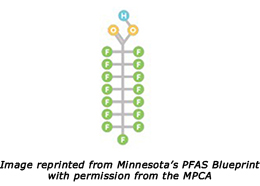PFAS
What do you need to know?

As PFAS, per- and poly- fluoro compounds also known as forever chemicals are increasingly in the news, many businesses are concerned about how they may be impacted by upcoming regulations.
What are PFAS?
What are PFAS used for?
Are PFAS in any of our products or raw materials?
How can we eliminate PFAS from our process?
If you are wondering about any of these questions, MnTAP has resources that can help!
PFAS are a class of fluorine containing human-synthesized chemicals that have been widely used in consumer and industrial products since the 1950s. PFAS do not readily break down, so they can accumulate in people and in the environment. This is a concern, because at least some PFAS are known to cause health problems such as immune suppression, cholesterol elevation, hormone disruption, decreased fertility, and kidney and testicular cancers.
PFAS have useful properties that make them common in many industries. Some of the most common uses are to reduce friction or surface tension, to increase wettability and to repel water, dirt or grease. Some industries are known for using PFAS, such as
- plating, which has historically used PFAS for fume suppressing,
- printing, which often has PFAS in inks to help them flow more smoothly, and
- semiconductor manufacturing, which typically uses PFAS for photolithography and etching.
However, other common uses of PFAS show up in any industry. Some of the most common of these include floor waxes, roofing materials, Teflon coated bearings and surfaces, and Teflon tape.
The European organization ChemSec has created a guide that includes uses of PFAS in various industries. MnTAP has adapted this into a resource to help facilities identify likely sources of PFAS in their process. Contact MnTAP for access to this resource.
One challenge with finding PFAS in products is that they are usually added in amounts too small to require disclosure on Safety Data Sheets (SDSs). More information is expected to become available in 2026 when new reporting requirements go into effect from the Toxic Substances Control Act (TSCA) and the State of Minnesota. In the meantime, the only way for most companies to find out for sure if there is PFAS in the materials they purchase is to ask their supplier. Further compounding the problem are the many different definitions of PFAS currently in use. The US Environmental Protection Agency (EPA) uses a structural definition. The Toxic Release Inventory (TRI) program uses a list. The State of Minnesota (along with at least 22 other states and the US Military), however, uses one of the broadest definitions of PFAS: a class of fluorinated organic chemicals containing at least one fully fluorinated carbon atom. To help navigate this situation, MnTAP has created a template for supplier inquiries, which explains what information manufacturers need to comply with Minnesota requirements.
What about alternatives to PFAS? While some applications already have PFAS-free alternatives available, in other areas these are still being developed. In some cases, such as cosmetics, ski wax, and many clothing applications, it may be possible to simply eliminate PFAS and still achieve satisfactory performance without any replacement. Waterproof clothing, firefighting foam, and fume suppressants for metal plating all have PFAS-free replacements available. Research is ongoing to identify alternatives in more areas. One recent example is the work the Toxics Use Reduction Institute (TURI) at the University of Massachusetts Lowell did with Transene Company to develop a PFAS free alternative for semiconductor manufacturing.
If you have questions about identifying PFAS in your facility, or finding effective alternatives, or you would like to learn more about MnTAPs PFAS resources,
Contact
Jane Paulson – Senior Engineer
Janep2@umn.edu
612-624-1826